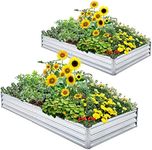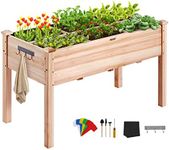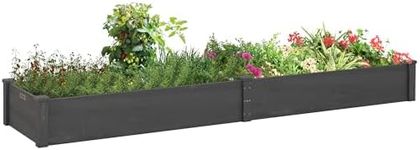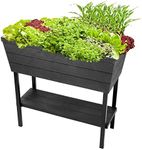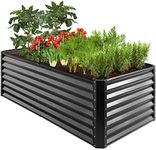Buying Guide for the Best Raised Garden Beds
Choosing the right raised garden bed can make gardening easier, more productive, and more enjoyable. Raised beds help improve soil quality, drainage, and can make gardening more accessible. When picking a raised garden bed, it's important to consider your available space, what you want to grow, and how much effort you want to put into setup and maintenance. Understanding the key features will help you select a bed that fits your needs and helps your plants thrive.MaterialThe material of a raised garden bed affects its durability, appearance, and how it interacts with your plants. Common materials include wood, metal, plastic, and composite. Wood is natural and blends well with gardens but may rot over time unless treated. Metal is long-lasting and modern-looking but can heat up in the sun. Plastic and composite beds are lightweight and resistant to rot but may not look as natural. If you want a bed that lasts many years with little maintenance, consider metal or composite. If you prefer a traditional look and don't mind occasional upkeep, wood is a good choice.
Size (Length, Width, Height)The size of your raised bed determines how much you can grow and how easy it is to reach your plants. Length and width affect planting space, while height influences soil depth and accessibility. Beds that are 3-4 feet wide are easy to reach from both sides, and lengths can vary based on your space. Heights range from 6 inches to over 2 feet; taller beds are easier on your back and allow for deeper-rooted plants. Choose a size that fits your space and matches your physical comfort and the types of plants you want to grow.
Assembly and InstallationSome raised beds are simple to assemble with basic tools, while others may require more effort or special hardware. Consider how much time and skill you want to invest in setting up your bed. Beds with interlocking panels or pre-drilled holes are easier for beginners. If you want a quick and easy setup, look for beds advertised as 'tool-free' or 'easy assembly.' If you enjoy DIY projects, more complex kits or custom builds might be appealing.
DrainageGood drainage is essential for healthy plants, as it prevents water from pooling and roots from rotting. Most raised beds naturally improve drainage, but some designs include extra features like drainage holes or open bottoms. If you live in an area with heavy rainfall or clay soil, prioritize beds with excellent drainage. For dry climates, you might want a bed that retains more moisture.
Mobility and PlacementSome raised beds are designed to be stationary, while others have wheels or are lightweight enough to move. If you plan to rearrange your garden or need to move beds to follow the sun, consider portable options. For permanent gardens, heavier or anchored beds are suitable. Think about whether you want flexibility in your garden layout or a fixed growing area.
Pest and Weed Control FeaturesCertain raised beds come with built-in features to help keep out pests and weeds, such as mesh bottoms, covers, or tall sides. If you have issues with animals or invasive weeds, look for beds with these protective features. If pests are not a major concern in your area, a simple open design may be sufficient.
